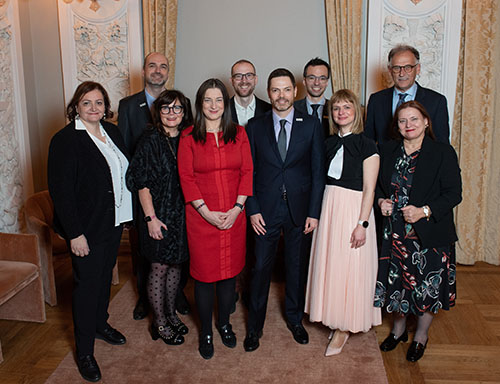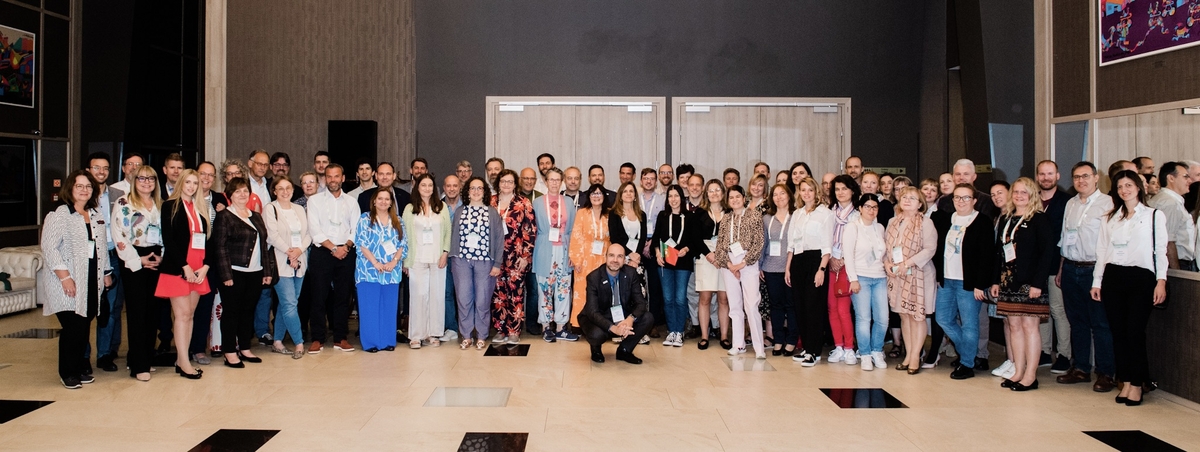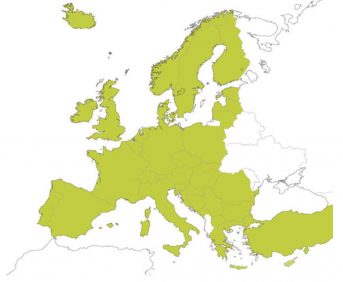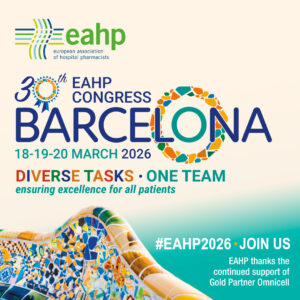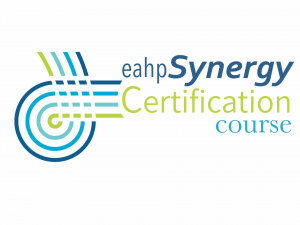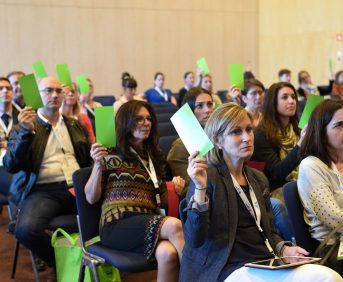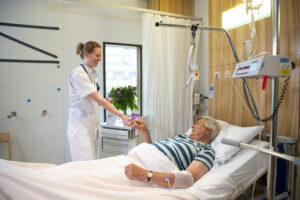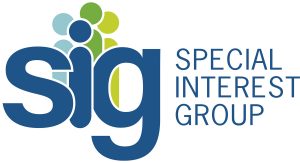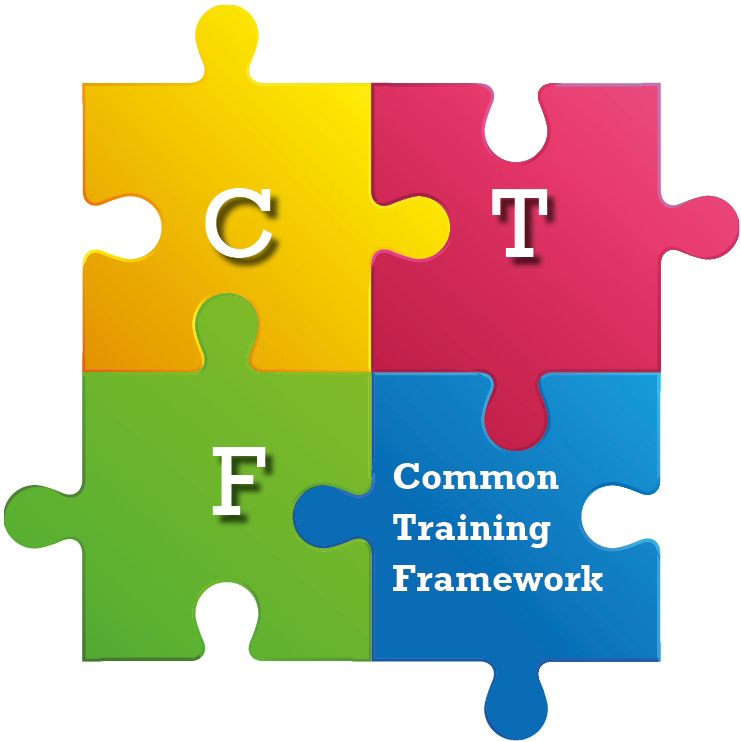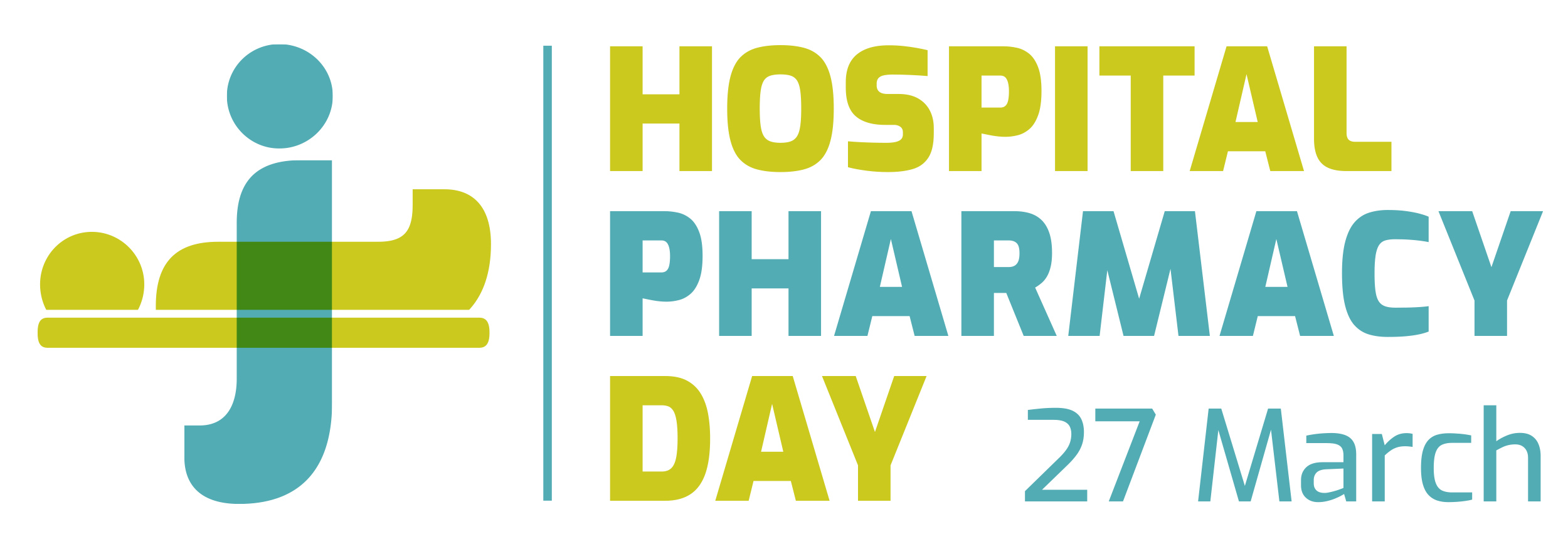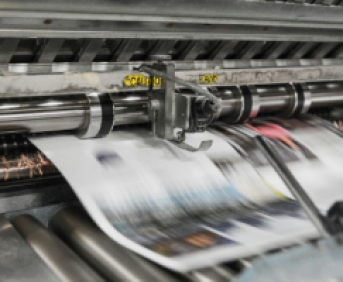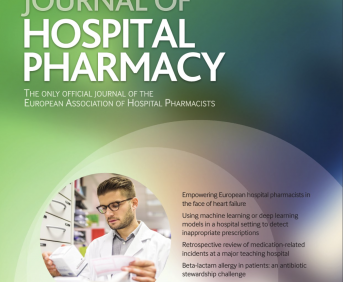How to be in friendzone: geriatric and pharmacy ?
European Statement
Clinical Pharmacy Services
Author(s)
François TISSERAND, Pierre MENAGER, Alexandre NAVID, Léa ROUSSET, Adeline BANNIER, Julie MORIO, Hélène PERRIER, Elsa JOUHANNEAU
Why was it done?
The geriatricians contacted the pharmacy to deliver training courses to the geriatric residents. This has enabled pharmacists to develop a close relationship with geriatricians to offer them clinical pharmacy activities in their ward. Geriatricians were familiar with clinical pharmacy, in particular the medication reconciliation, which is used to perform the former in other hospitals. Geriatricians are concerned with iatrogenic illness and therefore see medication reconciliation and pharmaceutical analysis as a relevant approach to clinical pharmacy.
What was done?
A successful model of partnership between Geriatrics and Pharmacy has been created and developed.
How was it done?
A first meeting was held between geriatricians and pharmacists. It was decided a pharmacy resident would be dedicated to a given geriatrician. This first resident’s objectives are to follow the medical rounds and to carry out medication reconciliations upon admission and discharge. Pharmaceutical support has enabled real-time validation for the prescription of the appropriate drugs. As the internship progressed, the resident became the privileged interlocutor for a Pharmacy-Unit relationship.
What has been achieved?
To date, 37 medication reconciliations were carried out, where the resident followed 2 medical rounds per week over 17 weeks. All unintentional discrepancies were corrected (n=13). Concerning the appropriateness of prescriptions, 16 inappropriate medications were stopped. During the medical rounds, 34% of the therapeutic problems (n=35) were related to inappropriate drug according to guidelines, 17% to dosing errors, 14% to drugs without indication. More than 50% of pharmaceutical interventions were judged capable of preventing harm that requires increased monitoring or treatment or lengthening of the hospital stay (63%). During this period, 54 questions were asked and discussed between the resident and the geriatrician to improve patient care. At the geriatricians’ request, two courses were organized about non mastered topics. On the ward, the resident acted as a go-between for a number of issues such as referencing medical devices, rearranging the storage of medicines or finding the right contact person for information activities.
What next?
What has been done needs to be continued and improved. A pharmacist-geriatrician cross-training should be implemented soon. New activities with pharmacist-geriatrician interactions are being created, such as day hospitalization for falls in the elderly population and a geriatric emergency unit.
Do we provide patients with sufficient information for the safe use of thermolabile medicines?
European Statement
Clinical Pharmacy Services
Author(s)
Miguel Angel Carvajal-Sanchez, Josefa Leon-Villar, Pilar Pacheco-Lopez, Javier Ibañez-Caturla, Paula Torrano-Belmonte, Lydia Fructuoso-Gonzalez, Juan Antonio Gutierrez-Sanchez, Maria Hernandez-Sanchez
Why was it done?
In recent years, we have witnessed a significant increase in the number of thermolabile pharmaceutical specialities, which makes it necessary to keep strict control of the storage temperature from manufacture to administration.
In this context, patient education is a fundamental step in ensuring that these medicines are administered effectively and safely.
What was done?
A study was carried out to determine the quality of the information provided by Hospital Pharmacy Service (HPS) professionals to patients regarding the storage of thermolabile medicines (TM) at home.
After analysing the variability of the results, we established in a protocolised manner the necessary and sufficient information items to be included in the pharmaceutical advice to patients regarding the storage of this type of medicines.
How was it done?
A random selection of 28 HPS professionals (13 nurses, 10 specialist pharmacists and 5 resident pharmacists) was made. Each participant, in isolation and individually, made a selection of criteria to be contained in the patient information regarding the transport and storage of TM.
The results obtained were:
General information:
o Informing that it is a TM: 89.28%.
o Telephone number for incidents: 10.71%.
o Keep out of the reach of children: 3.57%.
o Return if discontinuation of treatment: 3.57%.
Storage:
o Specify location in refrigerator: door/indoor distinction 28.57%; Avoid contact with walls: 28.57%; specific place in refrigerator 3.57%.
o Do not store next to food: 17.85%.
o Refrigerator/freezer distinction: 10.71%.
Transport:
o Recommendations for correct transport: 50%.
o Time elapsed from dispensing to refrigerator storage: 39.29%.
Administration:
o Tempering prior to administration (when necessary): 39.28%.
o Visual inspection: 7.14%.
o Check expiry date: 7.14%.
o Frecuency of administration: 3.57%.
What has been achieved?
Completion, standardisation and systematisation of the provision of information to patients on TM.
What next?
Training sessions will be given to all HPS professionals involved, including new recruits and pharmacy assistants. This is an initiative applicable to all HPS.
Medication reconciliation : a pharmaceutical teleconsultation for patients followed in hematology in a French Comprehensive Cancer Center
Pdf

European Statement
Clinical Pharmacy Services
Why was it done?
Oncology patients are often elderly and multi-medicated, with many physicians involved in their management. Their treatments can therefore often be changed while chemotherapy have a high risk of drug’s interactions. However, in our center, the length of patient stays and pharmaceutical resources are incompatible with the systematic achievement of reconciliation during hospitalization. In addition, more and more patients are benefiting from oral chemotherapy, outside any hospitalization. Besides, hematologists already offered teleconsultations to some patients, for their comfort and because of the COVID-19 pandemic.
What was done?
A pharmaceutical teleconsultation is now offered to our hematology patients in order to make the comprehensive list of medications taken, including self-medication, herbal medicines and food supplements. The comparison with the usual treatment in the medical record allows to update the patient file and prepares a proactive reconciliation.
How was it done?
A comparison and tests of the different reconciliation tools were carried out. The Hospiville® platform was chosen, also allowing remote and secure communication with retail pharmacies. Moreover, communication devices have been installed, such as webcams, headphones and microphones. This equipment was financed by our Regional Health Agency.
What has been achieved?
An appointment is offered to the patients listed on the weekly hematology teleconsultation schedule. Their usual pharmacy’s contact details are then requested.
Information collected from the medical file and from the pharmacy are provided on Hospiville®, then completed during the interview by Teams®. The pharmacist lists the prescribed medications, assesses the patient’s compliance and analyzes the interactions between drugs or complementary medicines. If necessary, the referring hematologist is contacted to adjust the drug’s management. Afterwards, the report of the teleconsultation is added to the medical file (Elios®).
What next?
By carrying out the consultation from home, patients report being more exhaustive in the information they provide. They also appreciate the short time needed and the easiness of speaking in familiar surroundings.
Thanks to scheduled teleconsultation, pharmacists further secure the patient’s medication path without disrupting the pharmacy’s activity. This experience will be used for the experiment “ORAL THERAPIES – home monitoring of patients on oral cancer drugs” in the French context of Article 51.
PERFORMING A COMMITTEE OF EVALUATION OF TREATMENTS IN SPECIAL SITUATIONS
European Statement
Clinical Pharmacy Services
Author(s)
Susana Redondo-Capafons, Laura Soriano, Irene López-Rico, Jorge Del Estal, Rocío Cebrián, Marcela Manriquez, Maria Reventós, Sandra Fernández-Molina, Mònica Gómez-Valent
Why was it done?
Before CTSS was performed, TSS were requested to Pharmacy Department for evaluation and decision. Because of complexity of these treatments, it was decided that it was necessary to evaluate them with other professionals to make a consensual decision.
In May 2019, CTSS was born. It is a multidisciplinary committee with 10 different health professionals: head of pharmacy, head of healthcare management, head of strategy and operations management, a clinical pharmacologist, five pharmacists and a secretary. Requesting doctors and heads of involved services are invited to explain TSS in the meeting.
What was done?
Committee (C) of Treatments in Special Situations (TSS) (CTSS) have been established. Requests are received by a specific email for the committee and a standard template was performed to be completed by requesting doctor (patient clinical information and evidence supporting request) and by Pharmacy Service (regulatory status of the drug, pharmacology and cost of treatment).
How was it done?
Some limitations as lack of human resources with exclusive dedication for making reports and lack of training in evaluation of this kind of treatments are the most important obstacles. Currently, each member is self-taught and under excessive work- pressure.
What has been achieved?
From May 2019 to August 2021, 273 treatments in 59 meetings sessions (average 4.63 evaluations/meeting) were evaluated.
The 91,6% of treatments were approved. In 95,9% of requests, one drug was evaluated.
There were 18 services involved, being oncology and hematology the most active departments.
Evaluated TSS were classified in six categories: 66,7% of requests were drugs without approved indication, 19,8% drugs approved indication pending price by government, 2,5% approved indication but denied funding by government, 1,8% foreign medicines, 4% compassionate use and 5.2% others according to criteria of each autonomous communities in Spain.
What next?
CTSS allows make a consensual decision between different professionals and establishes a flow to manage TSS requests. This multidisciplinary scenario generates knowledge and evidence in the use of these kind drugs reducing uncertainty in TSS use in relation to its efficacy and safety and, in cases of high budgetary impact-drugs, to minimize inequities of access by standardizing decision-making. Applicable to all hospitals.
Re-using mendeliome data to explore pharmacogenomics implementation: pitfalls and opportunities.
Pdf

European Statement
Clinical Pharmacy Services
Author(s)
Eline Coene , Catharina Olsen, Mathijs Swaak, Freya Vaeyens , Frederik Hes , Stephane Steurbaut, Sonia Van Dooren , Pieter-Jan Cortoos
Why was it done?
Pharmacogenomics has a large potential to optimize individual patients’ both current and future drug therapies. In Belgian hospitals however, pharmacogenomics is still rarely used in clinical practice posing great opportunities for hospital pharmacies to explore this field and setting up new services.
What was done?
The Centre for Medical Genetics (CMG) of UZ Brussel, a 721-bed tertiary hospital in Brussels (Belgium), has been performing next-generation sequencing of mendeliomes for diagnostic purposes since 2016. Pharmacogenomic data is thus potentially available, but currently not further used. As hospital pharmacists, we wanted to explore the possibility of reporting pharmacogenomic information as ‘secondary findings’, in particular prevalence of actionable pharmacogenes and gene-drug interactions (GDIs) in our own population, and to determine required features and opportunities of a future pharmacogenomics project
How was it done?
Firstly, 14 pharmacogenes comprising 626 loci were selected based on available guidelines, clinical relevance and whether the gene was included in the mendeliome gene set. With the support of CMG, we then reviewed available data for patients with a mendeliome analysis between 01/03/2016 and 30/06/2020. To enable haplotype assignment, a Python script was developed displaying possible haplotypes with corresponding ‘matching score’ and ‘completeness score’. Where possible, phasing was done using pedigree information. Resulting phenotypes were finally further linked with medication histories, abstracted from patients’ electronic medical records in order to identify possible GDIs.
What has been achieved?
Pharmacogenomic data could be re-used for 536 individual patients, revealing that at least 76.9% had one or more actionable phenotype while 60 GDIs with varying relevance were found. CYP2C9 had the most actionable phenotypes (174/536) and was involved in 42 GDIs. However, not all phenotypes (e.g. copy-number variants) were detectable for CYP2C19 and CYP2D6 due to limitations of current mendeliome data and used platform.
What next?
Reusing genomic data has great potential and can be an ideal stepping-stone towards developing and implementing pharmacogenomics in other hospital pharmacies but requires a good interplay between pharmacists, geneticists and bio-informaticians. In our hospital this initiative has led to in-depth collaboration between pharmacy and medical genetics department focusing on validation and implementation of a pharmacogenomics-array coupled with implementation of a pharmacogenomics service, next to pharmacological use of whole-genome sequencing data.
Securing the care pathway of patients in the new experimentation of medical cannabis through pharmaceutical interviews
European Statement
Clinical Pharmacy Services
Author(s)
Marie Guedon, Maëliss Laurent, Thibault Vallecillo, Catherine Mennesson, Mélanie Jennesson Lyver, Dominique Hettler, Céline Mongaret
Why was it done?
In March 2021, the “Agence Nationale de Sécurité du Médicament” initiated an experiment to evaluate the relevance and feasibility of the availability of MC as a narcotic drug, in France. In our hospital, we included children to treat drug-resistant epilepsy, and performed a dispensing process to secure the patient care pathway and strengthen collaboration between hospital pharmacists and primary care professional.
What was done?
The aim of this study is to secure the care pathway of patients included in a national experimentation of medical cannabis (MC) by developing pharmaceutical interviews. Thus, to optimize the continuity of patient care, a pharmaceutical report was developed, and addressed to the community pharmacists of the patient.
How was it done?
A working group was created including clinical pharmacists, a neuropediatrician and a coordination nurse. During medical consultations, pharmaceutical interviews were conducted and led to pharmaceutic reports, sent to the community pharmacies of the patients. In order to evaluate this report, a satisfaction survey was carried out.
What has been achieved?
During the first six months of the experimentation, three children were included. The clinical pharmacist team (two senior pharmacists and two pharmacy residents) performed ten dispensing processes. During the eight pharmaceutical interviews, four pharmaceutical interventions were performed. Firstly, the interaction between clobazam and MC (noticed in one patient) required a dosage adjustment. Then, the association between MC and hepatotoxic drugs (found in two patients) requires hepatic monitoring. A pharmacovigilance statement was also drafted to report side effects (digestive disorders). The satisfaction survey of community pharmacists showed that the transmitted information, mostly related to the medication review, was considered as useful for the community pharmacies of the patients. This data helped to guide the pharmaceutical interviews during their dispensing process.
What next?
Pharmaceutical interviews and their reports lead to secure the patient care pathway and improve the communication amongst health care professionals. Those measures provide an optimal case management and avoid therapeutic breakdown. Nevertheless, difficulties have been reported, mostly due to delay in the supply chain of the community pharmacies. Therefore, this system requires some adjustments before it can be applied on a larger scale. One of the suggestions is a provisional calendar of consultations and dispensations.
Critical points in the management of intratumoral treatments in oncology clinical trials
European Statement
Clinical Pharmacy Services
Author(s)
Lorena Garcia Basas, Pablo Latorre Garcia, Eugenia Serramontmany Morante, Patricia Garcia Ortega, Pilar Rovira Torres, Laura Maños Pujol, Isabel Cidoncha Muñoz, Maria Queralt Gorgas Torner
Why was it done?
Increasing number of CT with IT, in different pathologies, with different tumor locations, contributes an increase in the complexity of drug compounding and procedures. Their preparation, administration and handling requirements differ from current therapies.
What was done?
Identification of critical points concerning intratumoral treatments (IT) preparation in patients with cancer included in clinical trials (CT).
How was it done?
Ongoing CT with IT in our unit were reviewed to identify critical points regarding prescription and preparation process. 14 trials with IT, 8 (57%) of which have ongoing patients were identified. Two of these trials are “first in human”. The critical points were:
- Nature of the IT: virus (4, 29%), nanoparticles (3, 21%), ribonucleic acid (2, 14%), cyclic dinucleotides (2, 14%), monosaccharides (1, 7%), phospholipids (1, 7%) and proteins (1,7%).Particularly, virus have special safety measures and transport conditions
- Dosing units: mcg (4, 29%), plaque-forming unit/mL (PFU/mL)(3, 21%), mL (3, 21%), mg (2 14%), ng (1, 7%), 50% Tissue Culture Infectious Dose (TCID50)(1, 7%).
- Prior dilution before filling the syringe: 8 (57%) of our preparations require at least one prior dilution.
- Drug volume to prepare according to the tumor size: 8 (57%) IT preparations depend on the tumor size.
- Depending on the depth of the target tumor lesion (visceral or superficial), different size of needle is required. This is important because different priming volumes of the needles are necessary.
What has been achieved?
The whole information necessary for a complete prescription, validation and correct preparation goes further than information usually needed for current therapies such as chemotherapy. The results of the study of the critical points allow us to elaborate the standardized operational procedures (SOP) for each CT and IT. These SOPs include the necessary information for a correct preparation for each IT, reducing risk of mistakes and achieving uniformity in the process.
What next?
These types of therapies represent a challenge, and pharmacists have an important role in developing new procedures. Communication between radiology, oncology and pharmacy departments in a multidisciplinary teamwork is essential. This information may be useful to other centers due to the lack of experience and SOPs to work with this type of therapy.
Evaluation of pharmaceutical interventions documented by a pharmacy technician: where do pharmacy technicians have the biggest impact to avoid drug-related problems?
European Statement
Clinical Pharmacy Services
Author(s)
Ruth Borchers, Linda Krampe, Andreas Fischer, Christian Thomas, Holger Knoth
Why was it done?
The aim of this study was to identify the clinical pharmacy services where the integrating of pharmacy technicians have the biggest impact to avoid drug-related problems.
What was done?
In the field of clinical pharmacy services there are activities that are suitable for pharmacy technicians under the supervision of a pharmacist. At the university hospital in Dresden one full-time pharmacist and one half-time pharmacy technician (4h/d) are looking after 80 beds in the department of urology. The main tasks of the pharmacy technician are medication reconciliation as well as clinical prioritisation by using guidelines to identify patients who are at high risk of drug-related problems.
How was it done?
Since 2019 the pharmacy technician is recording the interventions in a categorical excel sheet, there are two documentation weeks per quarter. The categories are drug name, short description of the drug related problem, intervention, classification (dose-related problems, consultation of general practitioner, consultation of patient, electronic prescription, other drug-related problems after discussion with the pharmacist, drug substitution).
What has been achieved?
During 22 documentation weeks from 01/2019 till 09/2020 the pharmacy technician documented 468 interventions. The main interventions are drug substitution on admission considering local guidelines (n=181; 39%), consultation of the general practitioner because of identified discrepancies on the medicine lists (n=138; 29%) and consultation of patients because of identified discrepancies (n=78; 17%). Dose-related interventions and other drug-related problems are detected by the pharmacy technician and discussed with doctors under the supervision of the pharmacist (n=49; 10%).
What next?
Especially in the field of medication reconciliation trained pharmacy technicians can be suitable to prevent drug-related problems. The consultation of general practitioners and patients because of identified discrepancies on the medication lists are time-intensive and probably would not happen in the same way without integration of the pharmacy technician. The drug substitution in consideration of local guidelines and the preparation of the electronic prescription lead to fewer queries from nurses or doctors.
Further research should focus on the quality of pharmaceutical interventions conducted by pharmacy technicians under the supervision of pharmacists.
TELEPHARMACY ANALYTICS AND DATA VISUALIZATION THROUGH BUSINESS INTELLIGENCE
European Statement
Clinical Pharmacy Services
Author(s)
Cristina González Pérez, Laura Llorente Sanz, Ángel Liras Medina, Ana Andrea García Sacristán, María Molinero Muñoz, Lidia Ybañez García, José Alberto Peña Pedrosa, Henar González Luengo, María Luaces Méndez, José Manuel Martínez Sesmero
Why was it done?
Telepharmacy implementation in the context of SARS-CoV-2 pandemic conducted us through the management of a high volume of complex, real-time both clinical and economic data. A multidisciplinary working group (biomedical engineers from the Innovation Unit, clinicians, managers and hospital pharmacists) developed a software tool in April-May 2021.
What was done?
The design of an agile, customizable and dynamic dashboard for the visualization and analysis of Telepharmacy key performance indicators (KPI) through Business Intelligence (BI).
How was it done?
Phases:
1. Situation analysis. KPI definition. Ethics committee approval submission.
2. Extraction and processing of raw databases (Telepharmacy database, outpatient dispensing program, hospital admission database, drug catalog) through data mining.
3. Co-creation of the comprehensive dashboard in PowerBI®, by integrating database sources. Different panels have been designed where filters such as age, time frame, medical service, pathology, etc. can be applied.
• Description of general variables: patients, demography, shipments, time frame, medical department.
• Geolocation of the destinations of the patients’ home delivery.
• Pharmacological profile: top 10 drugs, distribution by active ingredient and drug classification group.
• Relative analysis of the beneficiary patients of Telepharmacy vs global outpatients
4. Pilot project by different types of users (administrative staff, clinicians and managers)
5. Structure design for automatic updating of the panels from the successive updates of the source databases
The quality of the raw databases can be a limitation. It has been necessary to define how to handle missing and duplicate data. Pre-processing, normalization and transformation data processes have been applied too.
Working within the hospital network ensures that there are no security gaps in terms of patient data protection.
For the external use of the dashboard, the granularity of the data is modulated to ensure enough clustering to avoid the identification of individual patients.
What has been achieved?
Processing the huge dataset (more than 2.4 million records) was possible by BI tools that synthesizes data, provides dynamic and engaging visualization (charts and graphs), allows the interactive reports customization for more effective communication of results and apply analysis based on Artificial Intelligence.
What next?
Applying new technologies will help us improve strategic decisions: interactions, behaviors and trends perceiving, weak points identifying, uncertainty reducing and over time monitoring.
EXPERIENCE OF PATISIRAN OPTIMIZATION BUILDING HEALTHCARE TEAM
European Statement
Clinical Pharmacy Services
Author(s)
CRISTINA GONZALEZ PEREZ, LUCIA GALÁN DAVILA, MARTA ORTIZ PICA, ELENA GARCIA SUAREZ, MARIA MOLINERO MUÑOZ, LIDIA YBAÑEZ GARCIA, NATALIA SANCHE-OCAÑA MARTIN, MARIA DE LA TORRE ORTIZ, JAVIER CORAZON VILLANUEVA, JOSE MANUEL MARTINEZ SESMERO
Why was it done?
Our hospital is a reference in our community for this rare disease. Since patisiran was approved, we have treated 19 patients. Due to the high cost of patisiran and the few patients treated, it is necessary to optimize patient treatments in the most efficient way.
What was done?
Transthyretin (TTR) amyloidosis is a rare disease caused by mutations in the TTR gene. These mutations alter the normal function of TTR protein, creating slowly progressive condition characterized by the buildup of abnormal deposits of amyloid in body’s organs and tissues.
Patisiran is a TTR specific small interfering RNA (siRNA) formulation in lipid nanoparticles, which has been shown to substantially reduce the production of abnormal TTR in patients with hereditary amyloidosis TTR.
With this project we look for achieve the greatest possible savings from patisiran drug without affecting the patient’s efficacy.
How was it done?
We created a working group with neurology department, to define patient’s groups according to:
– Prescribed doses (doses per patient weight; 0.3 mg/kg).
– Preparation’s losses because of the filters
– Losses of the extraction process.
– Other individual conditions as posology or personal preferences.
Patients belonging to the same group have to administrate patisiran the same days.
As the patient’s weight can change along the time, we agree with doctors and nurses to weight the patients every six months to perform doses adjustments. Therefore, every six months we should regroup the patients to optimize the most.
What has been achieved?
These clusters have made possible to reduce wasting vials and therefore to permit significant savings. We estimate around 208.115 € savings/year.
What next?
With this practice we look for a more efficient and sustainable rational health system. The savings achieved can be used to treat other patients or promote new investigations. Also, it makes possible a better healthcare team performance, working together for a better attention, health quality, security, and treatments efficiency. Monitoring weights to adjust doses and closer follow-up of patients by the different members of the multidisciplinary team are examples of the achievements.
